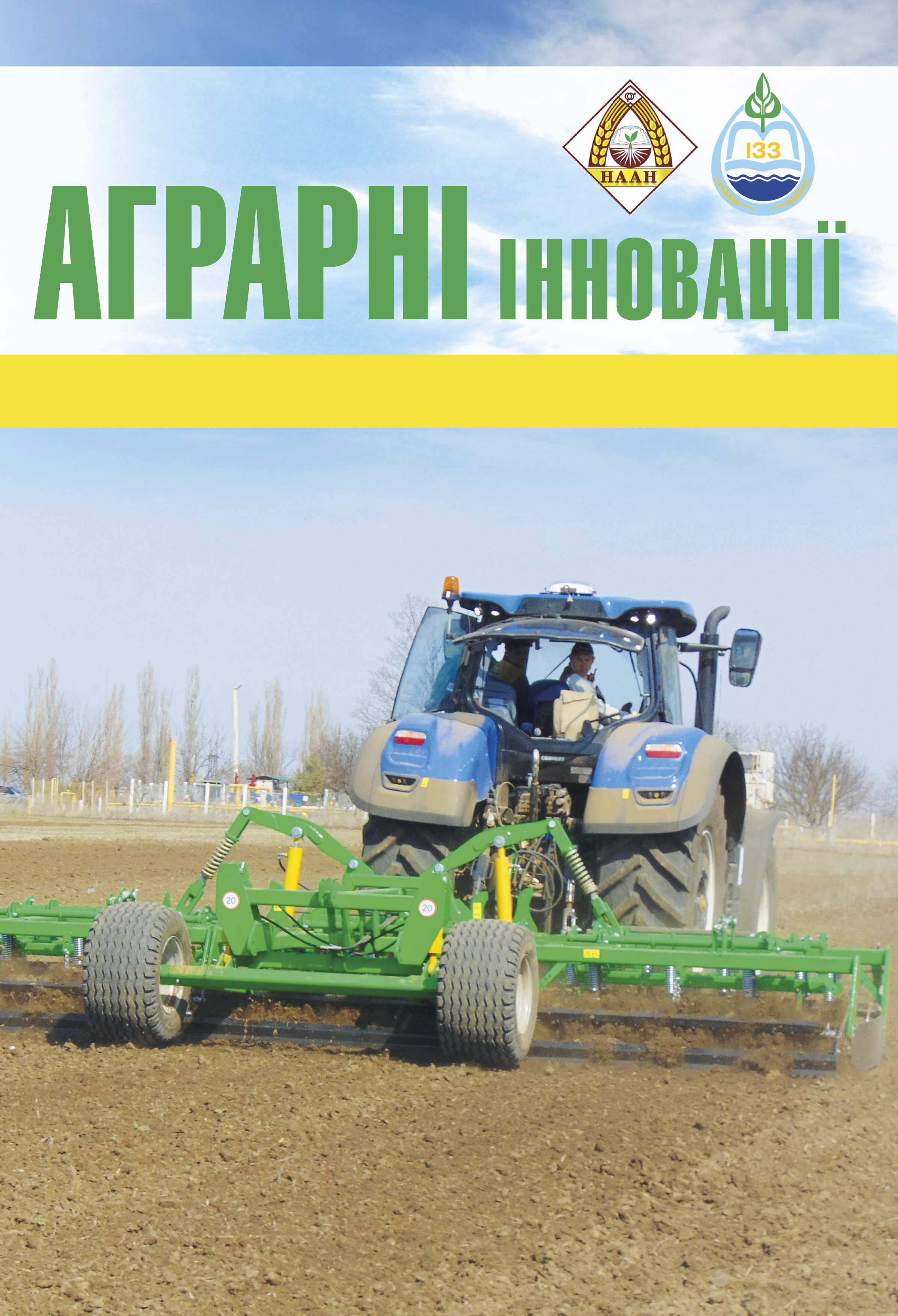THE IMPACT OF GROWING TECHNOLOGY ON THE GROWTH OF ABOVEGROUND MASS OF CORN HYBRIDS IN THE CONDITIONS OF THE NORTHERN STEPPE OF UKRAINE
Abstract
Purpose. To study the influence of the technology of cultivation of corn on the increase in height, the peculiarities of formation of aboveground raw mass and dry matter with plants corn the conditions of the northern steppe of Ukraine. Methods. Field and laboratory tests were conducted in accordance with modern requirements and standards of research business in agronomy and agriculture. These studies have made it possible to objectively evaluate the impact of various factors of corn cultivation technology on its development. Results. According to the results of the studies we conducted in 2022–2024, in the conditions of the northern steppe of Ukraine, the height of the plants of corn of the studied hybrids depended on the technology of cultivation and weather conditions of the year of the study of the year. The highest plants of corn of the studied hybrids were in 2023 According to the results of research, the highest height by No-Till growing technology is determined in the phase of full ripeness of grain – 240 cm in the hybrid of DCS 3730, in the variant of the use of classical technology of cultivation of crop crop plant height of the specified hybrid was lower by 5 cm or by 2.1 %. The studies conducted during 2022–2024 made it possible to identify the unequal impact of the studied technologies of cultivation on the processes of accumulation of raw above -ground mass of corn hybrids. Thus, on average, during the years of research and the factor of cultivation technology, the largest raw above -ground mass was formed by the plants of the hybrid of DCS 3730 -41.34 -42.99 t/ha, depending on the phase of growth and development of plants, which exceeded the indicators of hybrid DCS 4795 -1.52 -1,02. At the same time, for the cultivation of the studied hybrids of corn on the version of No-till technology raw aboveground mass of plants was the highest. Thus, on average, during the years of research and the hybrid factor, the plants were accumulated 41.9 – 42.99 t/ha of raw aboveground mass, depending on the growth and development of plants, which is more than the indicators of classical technology by 5.22 – 3.99 %. The maximum output of dry matter was set in 2023 – 19.58 t/ha on average on the variants of the experiment, which exceeded 2022 and 2024 and, respectively, by 1.2 and 2.3 t/ha or 6.53 and13.31 %. This figure was the lowest in 2024 and was 16.4 t/ha according to the experiment. Among the hybrid composition, the highest values of the accumulation of aboveground mass are set for the use of a hybrid of DCS 3730 17.82 – 18.41 t/ha, on average during the years of research and variant of cultivation technology, which is 0.96-1.66 % depending on the growth and development phase and development- DCS hybrid 4795. Conclusions. In the conditions of the northern steppe of Ukraine, the highest indicator of corn plants according to the technology of cultivation No-Till is determined in the phase of complete ripeness of grain – 240 cm in the hybrid DCS 3730, in the variant of application of classical technology of cultivation of culture of plants of the specified hybrid was lower by 5cm or 2.1 %. It is determined that the greatest output of raw above-ground mass, on average, during the years of research and the factor of cultivation technology, formed plants of hybrid DCS 3730 – 41.34-42.99 t/ha, depending on the phase of growth and development of plants, which exceeded the indicators of hybrid DKS 4795-2.6 %. The maximum output of the dry matter among the hybrid composition was established for the use of the hybrid of the DCS 3730 17.82-18.41 t/ha, on average during the years of research and variant of cultivation technology, which is 0.96 -1.66 % depending on the growth and development phase, than the use of the DCS 4795 hybrid. Thus, No-Till technology is an effective method for increasing corn yields, conservation of resources and ensuring steady productivity in difficult agroclimatic conditions. Given the results, No-Till can be recommended for widespread introduction in the agricultural farms of the Southern Steppe of Ukraine.
References
2. Peculiarities of Photosynthetic Activity of Winter Pea Plants Depending on the Sowing Rates / Rudenko V., Shcherbakov V., Panfilova A., Kogut I. Ukrainian Black Sea Region Agrarian Science. 2022. 26 (2). 53-58. https://doi.org/10.56407/2313-092X/2022-26(2)-6
3. Вожегова Р., Влащук А., Колпакова О. Вирощування кукурудзи на зрошенні в умовах Південного Степу України. Пропозиція. 2017. № 3. С. 104–108.
4. Lory J. A., Scharf P. C. Yield Goal versus Delta Yield for Predicting fertilizer Nitrogen Need in Corn. Agronomy Journal. 2015. №. 95. P. 994–999.
5. Saracoglu K., Saracoglu B., Fidan A. V. Influence of Integrated Nutrients on Growth, Yield and Quality of Maize (Zea mays L.). American Journal of Plant Sciences. 2011. Vol. 2, № 1. P. 63–69.
6. Barlog P., Frckowiak-Pawlak K. Effect of Mineral Fertilization on Yield of Maize Cultivars Differing in Maturity Scale. Acta Sci. Pol. Agricultura. 2008. №. 7. P. 5–17.
7. Лавриненко Ю. О., Туровець В. М., Лашина М. В. Комбінаційна здатність нового вихідного матеріалу кукурудзи добраного на раннє та пізнє цвітіння качана в умовах зрошення. Зрошуване землеробство. 2012. № 57. С. 237–242.
8. Методика польового досліду (зрошуване землеробство) / Ушкаренко В.О., Вожегова Р.А., Голобородько С.П., Коковіхін С.В. Херсон :Грінь Д.С., 2014. 448 с
9. Основи наукових досліджень в агрономії / Єщенко В., Копитко П., Опришко В., Костогриз П. Київ : Дія, 2005. С. 240–242.






